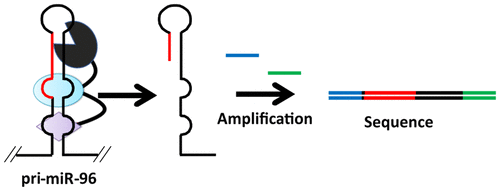当前位置:
X-MOL 学术
›
ACS Chem. Biol.
›
论文详情
Our official English website, www.x-mol.net, welcomes your feedback! (Note: you will need to create a separate account there.)
Precise Small Molecule Degradation of a Noncoding RNA Identifies Cellular Binding Sites and Modulates an Oncogenic Phenotype
ACS Chemical Biology ( IF 4 ) Pub Date : 2018-10-30 00:00:00 , DOI: 10.1021/acschembio.8b00827 Yue Li 1 , Matthew D. Disney 1
ACS Chemical Biology ( IF 4 ) Pub Date : 2018-10-30 00:00:00 , DOI: 10.1021/acschembio.8b00827 Yue Li 1 , Matthew D. Disney 1
Affiliation

|
Herein, we describe the precise cellular destruction of an oncogenic noncoding RNA with a small molecule–bleomycin A5 conjugate, affording reversal of phenotype and a facile method to map the cellular binding sites of a small molecule. In particular, bleomycin A5 was coupled to a small molecule that selectively binds the microRNA-96 hairpin precursor (pri-miR-96). By coupling of bleomycin A5’s free amine to the RNA binder, its affinity for binding to pri-miR-96 is >100-fold stronger than to DNA and the compound selectively cleaves pri-miR-96 in triple negative breast cancer (TNBC) cells. Indeed, selective cleavage of pri-miR-96 enhanced expression of FOXO1 protein, a pro-apoptotic transcription factor that miR-96 silences, and triggered apoptosis in TNBC cells. No effects were observed in healthy breast epithelial cells. Thus, conjugation of a small molecule to bleomycin A5’s free amine may provide programmable control over its cellular targets. Few approaches are available to define the binding sites of small molecules within cellular RNAs. Our targeted cleavage method provides such an approach that is straightforward to implement. That is, we determined experimentally the site cleaved within pri-miR-96 in vitro and in cells; these studies revealed that the site of cleavage is the precise site for which the small molecule cleaver was designed and in agreement with modeling. These studies demonstrate the potential of sequence-based design to provide bioactive compounds that precisely recognize and cleave RNA in cells.
中文翻译:

非编码RNA的精确小分子降解识别细胞结合位点,并调节致癌表型。
在本文中,我们描述了与小分子博来霉素A5共轭物的致癌非编码RNA的精确细胞破坏,提供了表型逆转和简便的方法来绘制小分子的细胞结合位点。具体而言,博来霉素A5与选择性结合microRNA-96发夹前体(pri-miR-96)的小分子偶联。通过将博来霉素A5的游离胺与RNA结合物偶联,其与pri-miR-96结合的亲和力比对DNA的亲和力强100倍以上,并且该化合物在三阴性乳腺癌(TNBC)细胞中选择性裂解pri-miR-96 。确实,pri-miR-96的选择性切割增强了FOXO1蛋白的表达,FOXO1蛋白是miR-96沉默的促凋亡转录因子,并触发TNBC细胞凋亡。在健康的乳腺上皮细胞中未观察到任何作用。因此,小分子与博来霉素A5的游离胺结合可以提供对其细胞靶标的可编程控制。很少有方法可以定义细胞RNA中小分子的结合位点。我们的靶向裂解方法提供了一种易于实现的方法。也就是说,我们通过实验确定了pri-miR-96中切割的位点体外和细胞中;这些研究表明,切割位点是设计小分子切割刀并与建模一致的精确位点。这些研究证明了基于序列的设计提供精确识别和切割细胞中RNA的生物活性化合物的潜力。
更新日期:2018-10-30
中文翻译:

非编码RNA的精确小分子降解识别细胞结合位点,并调节致癌表型。
在本文中,我们描述了与小分子博来霉素A5共轭物的致癌非编码RNA的精确细胞破坏,提供了表型逆转和简便的方法来绘制小分子的细胞结合位点。具体而言,博来霉素A5与选择性结合microRNA-96发夹前体(pri-miR-96)的小分子偶联。通过将博来霉素A5的游离胺与RNA结合物偶联,其与pri-miR-96结合的亲和力比对DNA的亲和力强100倍以上,并且该化合物在三阴性乳腺癌(TNBC)细胞中选择性裂解pri-miR-96 。确实,pri-miR-96的选择性切割增强了FOXO1蛋白的表达,FOXO1蛋白是miR-96沉默的促凋亡转录因子,并触发TNBC细胞凋亡。在健康的乳腺上皮细胞中未观察到任何作用。因此,小分子与博来霉素A5的游离胺结合可以提供对其细胞靶标的可编程控制。很少有方法可以定义细胞RNA中小分子的结合位点。我们的靶向裂解方法提供了一种易于实现的方法。也就是说,我们通过实验确定了pri-miR-96中切割的位点体外和细胞中;这些研究表明,切割位点是设计小分子切割刀并与建模一致的精确位点。这些研究证明了基于序列的设计提供精确识别和切割细胞中RNA的生物活性化合物的潜力。



























 京公网安备 11010802027423号
京公网安备 11010802027423号